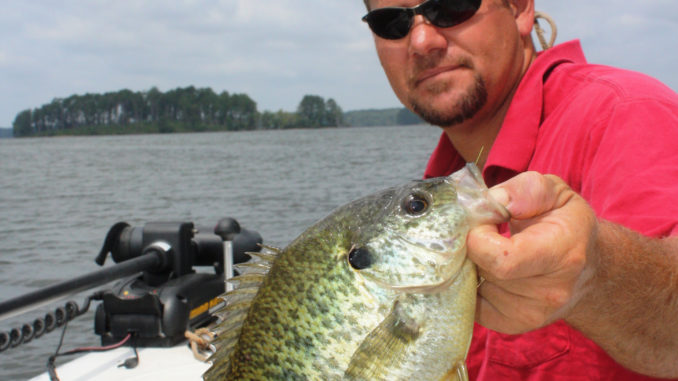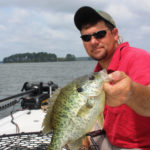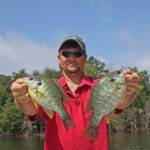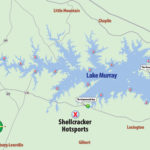
Great fishing for Lake Murray sunfish doesn’t end when the spawn does.
Perhaps the most underrated and overlooked fisheries at Lake Murray is the shellcracker. Many anglers enjoy the outstanding fishing for striped bass, largemouth and catfish, but often, the average angler knows little about the shellcracker.
According to local experts, Lake Murray shellcrackers grow to enormous sizes and the lake — among those in the know — is becoming one of the top shellcracker destinations in the state.
Brad Taylor is one of the few fishing guides who targets shellcrackers on a regular basis. He said fishing success isn’t simply reserved for springtime bed fishing; there’s outstanding fishing for huge shellcrackers on Murray from May on through the summer and into the fall.
“I love fishing for shellcrackers, and a typical shellcracker at Lake Murray is likely to weigh between one and two pounds,” he said, “but there are those days when you can catch a lot more of the bigger shellcrackers, pushing two pounds and even larger. For the top-end size here, I know of for certain two shellcrackers have been caught over four pounds. That’s a big panfish. One of the reasons I guide for these fish, in addition to crappie and stripers, is that they are abundant, great fun to catch and somewhat of a surprise fish for a lot of fishermen.”
Taylor (803-331-1354) said May can be a bit of a transition month for these fish, but much of that is weather dependant.
“A lot of shellcrackers typically will spawn in April if weather conditions are right,” he said. “They are usually a month or so ahead of the other bream species in terms of spawning. But by May, and certainly on though the summer, we’ll begin to find them on rock humps and high spots around the lake. But there’s still some shellcrackers to be taken on the beds in the creeks.”
Taylor said he prefers to fish in the upper half of the lake, but really, the entire lake is productive.
“I like the water depths in the upper half of the lake, but there are plenty of creeks and coves where shellcrackers spawn on the lower end of the lake, and also plenty of high spots for when they move off the beds,” he said. “It’s simply a personal preference for anglers.”
Taylor said fish tend to bed around the full moon, and that’s the best time to search for them. They don’t all spawn at the same time or in the same month, so fish can be found spawning in May, as well as being found in other areas.
“For spawning shellcrackers, I prefer to fish the larger creeks, and (I) will get back into secondary coves and pockets and simply move the boat along, casting in front of the boat looking for shellcracker beds.” Taylor said. “It’s very much like fishing for a regular bream or bluegill bed, except the fish will be much larger. Plus, the shellcrackers will sometimes get into surprisingly shallow water.
“I look for sandy and gravel-type bottoms, and the addition of a stump or piece of brush is good for shellcrackers. They will sometimes get tight to cover when bedding. When you find a bed, stay as far away as you can because the clear water typical of Lake Murray makes it more likely to spook the fish. I’ll make long casts to the edge of the bed and gradually work deeper into the bed as we catch fish. Sometimes, my clients can catch a limit from a bed, or we’ll have to resume the search and find other areas. But this is a great way to hook into some of the largest shellcrackers of the year.”
But it’s certainly not the only way, Taylor said.
“When spawning, they are on beds, but most of the time they are not spawning and they have a very identifiable type of target they prefer as the spawning ends and the water warms,” he said.
According to Taylor, the key to finding shellcrackers after the spawn and through the summer and fall is fishing hardbottom areas such as rocks and gravel on offshore humps and points.
“A lot of lakes will have different patterns for shellcrackers, but at Lake Murray from now right on through the fall, the rocky humps, points and ledges with hard gravel or rock bottoms around the lake provide ideal cover for the shellcrackers,” Taylor said. “And the size continues to be outstanding, especially for warm-weather fishing. Even after the spawn, the average size is around one pound, which is a hefty shellcracker. But it’s not unusual to catch fish in the 1- and 1 1/2-pound and larger class, which are mountable specimens for some fishermen.”
Doug Lown of Newberry guided on Lake Murray for 20 years, and while he no longer guides, he still fishes a lot for shellcrackers as well as largemouth bass. Lown said that some of his prime places to find shellcrackers are gravel and sand points in major creeks and coves.
“One thing about shellcrackers on Lake Murray in May is that fishermen are prone to find them in prespawn, spawn and post-spawn conditions,” he said. “So while looking for bedding areas is a good idea, working the other type places are likely to produce as many, if not more, fish. Plus, as (you get) into late May, June and beyond, these offshore humps and points will be the prime places.”
Lown said it’s important that fishermen know their quarry; shellcrackers are primarily bottom-feeders, so fishing on the bottom is crucial.
“Regardless of where you fish, on the beds or on the points and humps, shellcrackers prefer to feed on the bottom,” Lown said. “As their name implies, they prefer to eat food sources such as mussels, snails and clams, and they are equipped with the ability to crush and crack shells to get food. I’ve found it by far best to fish for them on the bottom.”
Taylor said that some shellcrackers two pounds or larger are taken after the spawn, but fish of that size are caught less frequently in hot weather.
Taylor’s technique is simple and very effective. Using lake maps and his electronics, Taylor anchors in six to 12 feet of water on rock piles or points with rock, gravel or hard sandy bottom, and he fan-casts rigs around the boat. He said the best areas are often close to much deeper water. Sometimes, the bottom is strewn with big boulders.
“I cast these rigs to different depths and areas all around the boat,” Taylor said. “Often, shellcrackers will be in one distinct area, but it can change daily. I usually fish an area for no more than 20 to 30 minutes if action is slow. I use eight rigs, and usually by the time I get them set out, I’m getting bites if it’s going to be a productive place. Once I get a depth pattern, that pattern will generally hold true for that day. These fish do seem to roam a bit, and sometimes where you catch them one day will not be productive the next time you go. So give each spot a little time to produce,, then move to the next target.
“When I find the right place we will usually catch several big shellcrackers from the same area, and in some lucky cases we’ll catch a limit,” he said. “They are not bedding on the humps and points, but they do often cluster up in big numbers. Typically, we have to move around and find fish at two or three places to get our limits but that’s just part of the shellcracker-fishing process, whether bed fishing or fishing the points and humps.”
DESTINATION INFORMATION
HOW TO GET THERE — Access to Lake Murray is easy, since it lies close to I-20, I-77 and I-26. Larger nearby towns include Lexington, Chapin, Gilbert, Prosperity and Irmo. Numerous launching ramps are available across the lake. For a complete listing, visit: www.dnr.sc.gov/mlands/boatramp/?p_type=1224900.
WHEN TO GO — Fishing is productive from late spring through the fall, but May is great for both bedding fish shallow and post-spawn fish on points and humps. As the summer continues, great fishing continues on offshore points and humps using nightcrawlers. Look for humps that come to within six to 12 feet of the surface, with hard, rocky bottoms as best places.
TECHNIQUES — Fish multiple rods in rod holders around points and humps. For bed fishing, simply cast ahead of the boat as you move into coves and pockets looking for cover that will hold fish on shallow sandy or gravel bottoms. Fishing for shellcrackers is good across the entire lake, but guide Brad Taylor prefers the upper half.
GUIDES/FISHING INFO — Capt. Brad Taylor, Taylor Outdoors, 803-331-1354, www.tayloroutdoors.com. See also Guides and Charters in Classifieds.
ACCOMMODATIONS — Lake Murray Country, www.lakemurraycountry.com; SC Department of Parks, Tourism and Recreation, Columbia, 866-244-9339; South Carolina Association of Visitor Bureaus, www.discoversouthcarolina.com.
MAPS — Navionics Electronic Charts, 6 Thatcher Lane, Wareham MA, 02571; Delorme’s South Carolina Atlas & Gazetteer, 800-561-5105, www.delorme.com; Kingfisher Map 800-326-0257, www.kfmaps.com.





Be the first to comment